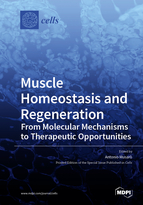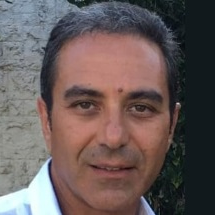Muscle Homeostasis and Regeneration: From Molecular Mechanisms to Therapeutic Opportunities
A special issue of Cells (ISSN 2073-4409).
Deadline for manuscript submissions: closed (30 April 2020) | Viewed by 154019
Special Issue Editor
Interests: aging and neuromuscular diseases; role of stem cells and tissue niche on muscle regeneration; role of growth factors and cytokines in the physiopathology of skeletal muscle
Special Issues, Collections and Topics in MDPI journals
Special Issue Information
Dear colleagues,
The capacity of adult muscle to regenerate in response to injury stimuli represents an important homeostatic process. Regeneration is a highly coordinated program that partially recapitulates the embryonic developmental program and involves the activation of the muscle compartment of stem cells, namely satellite cells, as well as other precursor cells, whose activity is strictly dependent on environmental signals. However, muscle regeneration is severely compromised in several pathological conditions due to either the progressive loss of stem cell populations or to missing signals that limit the damaged tissues from efficiently activating a regenerative program. It is, therefore, plausible that the loss of control over these cells fate might lead to pathological cell differentiation, limiting the ability of a pathological muscle to sustain an efficient regenerative process. This Special Issue offers an Open Access forum that aims to bring together a collection of original research and review articles addressing the intriguing field of the cellular and molecular players involved in muscle homeostasis and regeneration and to suggest potential therapeutic approaches for degenerating muscle diseases. We hope to provide a stimulating resource for the fascinating subject of muscle research.
Prof. Antonio Musarò
Guest Editor
Manuscript Submission Information
Manuscripts should be submitted online at www.mdpi.com by registering and logging in to this website. Once you are registered, click here to go to the submission form. Manuscripts can be submitted until the deadline. All submissions that pass pre-check are peer-reviewed. Accepted papers will be published continuously in the journal (as soon as accepted) and will be listed together on the special issue website. Research articles, review articles as well as short communications are invited. For planned papers, a title and short abstract (about 100 words) can be sent to the Editorial Office for announcement on this website.
Submitted manuscripts should not have been published previously, nor be under consideration for publication elsewhere (except conference proceedings papers). All manuscripts are thoroughly refereed through a single-blind peer-review process. A guide for authors and other relevant information for submission of manuscripts is available on the Instructions for Authors page. Cells is an international peer-reviewed open access semimonthly journal published by MDPI.
Please visit the Instructions for Authors page before submitting a manuscript. The Article Processing Charge (APC) for publication in this open access journal is 2700 CHF (Swiss Francs). Submitted papers should be well formatted and use good English. Authors may use MDPI's English editing service prior to publication or during author revisions.
Keywords
- muscle homeostasis
- muscle regeneration
- satellite cells
- stem cells
- FAPs
- tissue niche
- growth factors
- inflammatory response
- muscle pathology
- aging







